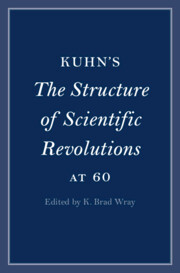Book contents
- Kuhn’s The Structure of Scientific Revolutions at 60
- Cambridge Philosophical Anniversaries
- Kuhn’s The Structure of Scientific Revolutions at 60
- Copyright page
- Dedication
- Contents
- Figures
- Tables
- Contributors
- Acknowledgments
- Abbreviations
- Introduction
- Part I Writing Structure
- Part II Normal Science and Science Education
- 3 Kuhn’s “Fifth Law of Thermodynamics”
- 4 Normal Science
- 5 “Textbook Science” before and after Structure
- 6 Thomas Kuhn, Normal Science, and Education
- Part III Incommensurability, Progress, and Revolutions
- Part IV Kuhn’s Impact on the Philosophy, Sociology, and History of Science
- Bibliography
- Index
6 - Thomas Kuhn, Normal Science, and Education
from Part II - Normal Science and Science Education
Published online by Cambridge University Press: 05 January 2024
- Kuhn’s The Structure of Scientific Revolutions at 60
- Cambridge Philosophical Anniversaries
- Kuhn’s The Structure of Scientific Revolutions at 60
- Copyright page
- Dedication
- Contents
- Figures
- Tables
- Contributors
- Acknowledgments
- Abbreviations
- Introduction
- Part I Writing Structure
- Part II Normal Science and Science Education
- 3 Kuhn’s “Fifth Law of Thermodynamics”
- 4 Normal Science
- 5 “Textbook Science” before and after Structure
- 6 Thomas Kuhn, Normal Science, and Education
- Part III Incommensurability, Progress, and Revolutions
- Part IV Kuhn’s Impact on the Philosophy, Sociology, and History of Science
- Bibliography
- Index
Summary
Kuhn’s notion of normal science seemingly advocated doctrinaire science education. This chapter documents this in Kuhn’s writings, and considers the argument from Popper, Feyerabend, and others that Kuhnian normal science would encourage dogmatism and stifle innovation. The chapter argues that it is possible to ameliorate the dogmatism in science education while respecting the necessities of professional training. Modern science can afford to maintain multiple paradigms within a field, producing the benefits of toleration while maintaining the advantages of Kuhnian normal science within each paradigm. Moreover, it is possible to educate each scientist in a pluralist way, fostering innovative thinking. The chapter argues that such pluralism is already present in physics education to a surprising extent and that it can plausibly be extended further.
- Type
- Chapter
- Information
- Kuhn's The Structure of Scientific Revolutions at 60 , pp. 121 - 134Publisher: Cambridge University PressPrint publication year: 2024

